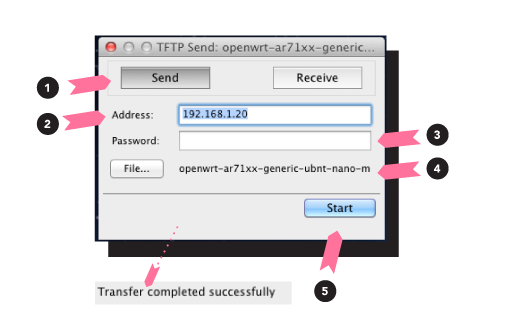
- Osx tftp client how to#
- Osx tftp client pro#
- Osx tftp client software#
- Osx tftp client plus#
- Osx tftp client windows#
Remainder of the boot process is mostly the same as a standard local-disk boot. Mounts the Netboot disk image via NFS and loads the kernel extension cache.

The computer has loaded the kernel and the boot process has begun. The spinning globe turns into a circular progress indicator The computer is loading the boot file, which downloads and loads the kernel andĤ. The gray Apple logo and a small spinning globe appear The computer is requesting an IP address and Netboot information, and beginsģ. The computer runs a self test and loads the machine firmware. Here is a brief overview of what happens when you Netboot a client, and what you'll see on the NetBoot experience on the EFI and OF-based Macs. Also take a look at this video comparing the In cases where EFI and Open Firmware behave the same, I have replaced platform-specific These changes will be marked with "†(EFI)". NetBoot process is exactly the same for EFI-based Macs, I will point out any differencesīetween the two platforms throughout the article. Instead of Openįirmware, the Intel Macs use Intel's Extensible Firmware Interface (EFI).
Osx tftp client how to#
Lay out the steps of the Netboot process on Mac OS X clients and indicate what technologiesĪre involved at each step, how they could fail, and how to solve the issue.ġ-19-06 Update: On January 10th, Apple announced new Intel-based Macs. As such, troubleshooting it can be challenging. Network booting a computer is a fairly straightforward, yet complex task involving manyĭifferent pieces of technology. I will paste it below.ī: Troubleshooting the NetBoot Process 11-11-01 3:15 PM Not sure about in a subnet but I have to guess that since some of NetBoot's protocols are very DHCP-like that the feature would try to quash any server trying to offer this service to clients in the same subnet as well.Īh, I found the document by Mr. If this is on, NetBoot across subnets doesn't work. There are lots of threads here on how to solve that one.Īnother potential issue is a feature our network support staff call "DHCP Snooping". The iMac (Mid-2010) has an issue where the kernelcache cannot exceed a certain size. Bombich wrote a lovely article on troubleshooting NetBoot which is very hard to find.
Osx tftp client software#
Still annoyed with Apple for killing their server hardware and hobbling their server software for SOHO use instead of Enterprise/Education.)
Osx tftp client windows#
(Yes, I tried updating to later versions of the OS but none of them seemed to work with our Windows clients and our Xserve is now end-of-life and will be shut off in a few weeks for the last time. They are all successfully booting from our Xserve running OS X 10.6.8.
Osx tftp client plus#
Plus we have a couple of Mac Mini units, the all aluminum form-factor from various years.
Osx tftp client pro#
Our client machines are as follows: iMac12,1 (21.5-inch Mid-2010), MacPro5,1 (Mid-2010), MacPro6,1 (Late 2013), iMac17,1 (iMac 5K, 27-inch, Late 2015) and we sometimes will NetBook our MacBook Pro units which can be anything from mid-2013 to the generation before the TouchBar. However, I don't think I've had to use that for a few years. If you changed "false" to "true" the server would support NetBoot for older machines. I recall on our Xserve there was a plist that we had to modify for some machines. Yes, there are at least two major versions of NetBoot. In my role, I do not have much insight into the various network infrastructure but I should be able to find the answer.

If I need to clarify or answer any questions, please ask. My question is simple: Are there different protocols, behavior, firmware or ? between models with respect to NetBoot processes? The baffling thing is that it should be binary-they all either NetBoot or they don't. Obviously, there is something that is not routing or being allowed that did not transfer during the migration. I have a Test Mac Pro with a Dev/Test JSS that is outside of the data center and all models work and Netboot as expected. We are currently packet sniffing and trying to chase it down from that end. Tested models that DO work: MPB's from 2010-there may be others but we have not found/tested them. Tested models that do NOT work: Late 2015 iMac, Late 2012 Mac Mini, Late 2012 iMac. Since the migration, certain vintages of the Macs I manage no longer complete the NetBoot process-they time out and then boot to whatever resident OS is currently on the hard drive of said Mac. ALL existing rules were migrated to the Palos (supposedly ). Over this past break session, our networking team migrated from Tipping Point to Palo Altos in our DC. This is a perfect time to perform upgrades, migrations, and other changes. The University of NM closes completely over the holidays. Before I get to that let me give you the answer to "What has changed?" My environment is experiencing strange NetBoot issue.


 0 kommentar(er)
0 kommentar(er)
